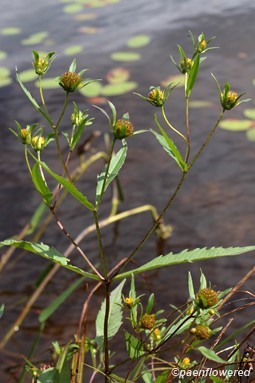Bidens connata
Bidens connata purplestem beggarticks
This species is a member of the aster family, but part of a subgroup that are called the bur-marigolds, begger ticks, tickseed sunflowers or sticktights. All have opposite toothed leaves, sometimes deeply divided. They have composite flowers, sometimes, but not always with long, showy, yellow ray florets that are at least as long or longer than the outer leafy bracts. There is so much variability within this group that identification is often based on technical details.
This species has lance-shaped undivided leaves with long stalks, though some of the lower leaves may be 3-cleft. The stem is smooth and purple or red in color. For this reason it is sometimes called the purple-stemmed swamp beggar tick. Although related species have showy yellow ray flowers (petals) this species usually has no rays at all or just a few small ones. There is only a yellow or brown central disk. The green bracts below the central disk can be quite long. The seeds are an achene with barbs (awns) that stick to fur or clothing. In this species there are 2-4 of these awns.
The plant grows 1-7 feet tall and is common in swamps and moist soil throughout eastern North America. It blooms from August to October. The European or trifid beggar-tick (B. tripartita) is similar but it has most of its leaves divided into three parts with the central one much longer than the others. It also has a leaf-winged stalk. The leafy-bracted beggar-tick (B. comosa) is also similar, but the leaves taper to wing-margined stalks or they have no stalks. The bracts on the latter species are also more leaf-like, often with teeth. The similar bur-marigolds have showy yellow ray florets. Of these B. cernua is most likely to be mistaken for thes swamp beggar-tick because it tends to have small ray florets and undivided leaves.
Habitat & Range
Frequent in swamps, bogs, moist meadows, and along streamlets.
Present throughout the state, other than at high elevations.
Wetland code: FACW
Phenology
Flowers August to October.
Plant Codes
S-rank: No rank
G-rank: G5 (Secure)







Comments
Have you spotted this plant in your area? We'd love to hear about your experience! Share your comments or questions about the plant below. Comments are moderated before posting.